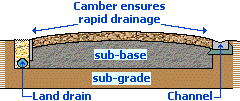 How to lay a driveway
How to lay a driveway
Decide where the driveway is to run, and mark out as required. It is assumed that the drive is to be flush i.e. level, with the existing ground. On wet or waterlogged ground, it will be advantageous to install a land drainage system along the edges of the drive. Larger driveways should be cambered (i.e. slightly higher in the centre than at the edges, as most roads are) to assist rapid drainage and minimise waterlogging.
Sub-grade
The surface needs to be dug off to a minimum depth of 135mm, or 180mm for heavier vehicles such as vans and pick-up trucks. Any soft spots should be excavated and filled with compacted sub-base material. Remove all weeds and other unwanted organic matter. On ground troubled with weeds, the excavated sub-grade should be doused with a general weedkiller such as Sodium Chlorate and/or consider using a permeable geo-textile. These geo-textiles can also help to ‘stiffen’ less firm ground as well as preventing the sub-base being driven into the sub-grade which can result in the sub-grade ‘pumping’ up into the sub-base.
If an edging restraint is needed, construct it now, before laying the sub-base. The gravel can become mixed with surrounding soil or lawn very easily. An edging helps to keep the gravel where it should be and off the surrounding grounds. Timber gravel boards, a brick edging or edging kerbs are fine.
Sub-base
This layer provides the strength and competence of the gravel drive. It should consist of a 130mm layer of DTp Type 1 granular sub-base material, hammered down with a vibrating plate compactor or vibrating roller, both available from local hire shops, to an approx compacted thickness of 100mm. For heavier applications, use 180mm of hardcore, compacted to 150mm thick.
1 tonne of DTp 1 covers approx 5 m² at 100mm compacted thickness, and approx. 3.5m² at 150mm compacted thickness.
Surface
This part of the construction is exactly the same as that given above for paths. Any size gravel or other surface dressing can be used for a driveway, although 10mm is the most popular choice. Any aggregate larger than 20mm poses a hazard if flicked up by the tyres of traffic using the driveway.
A harder gravel, such as granite, flint or magnesian limestone is a good choice for driveways. Some of the softer local gravels, such as Cotswold buff limestone or Keuper sandstone, are relatively soft and can be rapidly crushed to dust by repeated trafficking.
It is recommended that the gravel is compacted or rolled to aid settlement, but it may take some time before it becomes thoroughly embedded in the underlying sub-base.
Feel free to browse our range of Decorative Aggregates.
